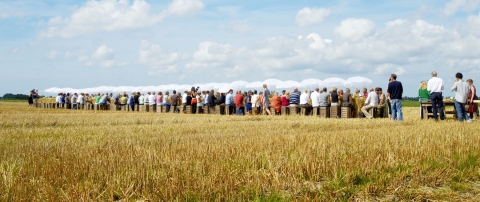
Polderlunch >
Learn more about Polderlunch, a communal meal hosted by Atelier NL and attended by the farmers of the Noordoostpolder.
The Polderceramics dinner set has been made directly from the soil surrounding the farms. This way, the vegetables eaten for dinner can be served from the very same soil that produced them; milk is poured from a pitcher made from the same earth the cow grazed, or a bowl cradles strawberries in the same earth from which they grew. Each clay sample that was excavated from the land of a Noordoostpolder farmer has been processed and refined into ceramic tableware with its own unique identity. The Polderceramic line retains evidence of a handmade process and reflects the rectilinear shape of Noordoostpolder farm plots. Simultaneously, contemporary identity arises from the addition of legs, handles, and spouts made of ceramic, glass, and tin from the traditional collections of famous Dutch companies Royal Tichelaar Makkum, Royal Leerdam, and Tingieterij Leerdam. Upon the completion of the line, Atelier NL invited photographer Paul Scala to document the tableware via compositions that pair the ceramics with local crops. This led to a series of vibrant still lifes that allude to the mood of 17th-century Dutch paintings.
Photography by Paul Scala
"We wanted to make tableware so that the vegetables prepared for dinner could be served from vessels which were made from the soil they came out of."
It's likely that you know more about the origins of the food on your plate than about the plate itself. Atelier NL dug into this matter by investgating the farmlands of the Noordoostpolder — a region in the central Netherlands that was reclaimed from the sea. By gathering samples of soil from farm plots, they worked the earth into usable clay. Using this method, they moulded the earth itself into natural tableware that is both distinctly modern and classically Dutch.
After collecting soil, Lonny and Nadine were ready to make clay. They sifted it into a fine powder removing any roots, twigs or shells that could cause cracking. The resulting powder was mixed with water and the clay was pressed into moulds. The Polderceramic sets include a bowl, plate and cup, as well serving vessels and bulb vases inspired by Atelier NL's research into the evolution of dinner sets. According to Nadine, "Our grandmothers had a piece for every function, with all kinds of shapes and subtleties. For example, a potato bowl has two handles placed horizontally, but on a soup bowl, they are vertical. We played with how the embellishment changes the function." Although Atelier NL's Polderceramics nod to history and tradition, they are far from historical replicas from days of old. Rather, they link past to present using modern shapes that are stoic and strong — like the farmers themselves — along with key embellishments that honour the legacy of Dutch tableware.
Every vessel is geo-stamped with the number of its corresponding farm plot.
The curved blue feet of this strawberry plate were borrowed from traditional ceramics in the Royal Tichelaar Makkum line.

Learn more about Polderlunch, a communal meal hosted by Atelier NL and attended by the farmers of the Noordoostpolder.










